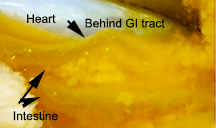Mollusc dissections are the only true dissections we do in the course and it because molluscs have taken the same basic components, such as a foot, radula, mantle, gills and modified them to produce groups as diverse as bivalves and chephalopods.
Generally students examine a mussel and a squid.
Mussel
Please visit these website for excellent videos on mollusc dissection. Unfortunately our attempts were compromised by mussels held too long in captivity and delivered in emaciated conditions.
http://www.youtube.com/watch?v=Ixc_-KndPdY
https://www.youtube.com/watch?v=C-3GqvLswc8-------------------note the difference in the foot the two different species.
Here is a film made by a former student i that give a better close up view of the dorsal outer surface focusing on the of gill (~09), foot (yellow, not brown nor spade-like, in our mussels) (~20) and labial palps (-26). The film then backtracks along the inner surface to stop at where if the animal were dissected out of its shell, you could see the heart.
As indicated in you tube films, it is difficult to see the pericardial cavity or heart in mussels. It is right next to edge of the shell and often damaged when the two shells are opened. Examine the last you tube film about 8.49 or student film at the end.


You would need to dissect the whole animal out of the shell and look at it dorsal side up before separating the two halves of the animal to see it most easily.
It is easier to see it in the oyster because the pericardial cavity is more central. Examine the film below that shows a beating heart in the oyster where that it is a membranous cavity is apparent. It is one of the few places where you can find eucoelom in mollusks. https://www.youtube.com/watch?v=FWhabyLyI2s
We do have some good shots of a clam using its siphon and foot.
Watch carefully for rejection of material from the siphon
That foot is more useful than one might suppose from a dissection. Lighting is from below at end of film to show clam using incurrent siphon.
Squid dissection
Please view the squid dissection.
Additional close-ups of squid radula and suckers.
The dissected radula of the squid
.
Tentacles contain teeth which hang on to prey.